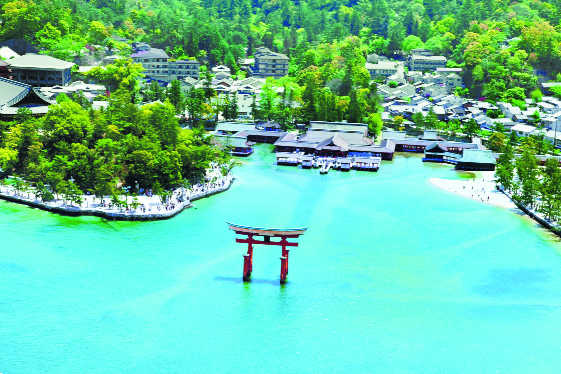
Miyajima overview with Otorii Gate in foreground
Tanushree Podder
God works harder than human beings. Naturally then, he needs a resting place and he has found one at the beautiful island of Miyajima. Known as the resting place of the Gods, this island, with its thick forest and sacred shrines, is one of the three most scenic spots in Japan. Miyajima, an island in the Hiroshima Bay, is also known as Itsukushima and the Itsuku-shima shrine, now a Unesco World Cultural Heritage Site, dates back to 593. In the olden days, women were not allowed to visit the island. Ancient rules also prohibited burial and cultivation on the island, in order to maintain the purity of the place. Although efforts have been made to retain the ambience, some of the ancient rules are no longer followed.
The first sight of the island, as the ferry draws closer to the island, comes in the form of a 16 metres high gate of exceptional beauty, looming up from the ocean. The Otorii Gate, a fitting symbol of Miyajima, is crafted out of camphor wood and stands in the ocean bed, roughly 200 m from the main shrine. A striking structure of vermillion and yellow, it looks resplendent in brilliant sunshine. During the low tide, when the water has ebbed, visitors to the shrine can walk through the gate for their tryst with the divinity but the real beauty of the portal is during the high tide when it seems to be floating on water.
A large number of deer roam all around the island. They have been on the island for many centuries. They are revered as sacred animals by the locals. Today, there are about 500 deer in Miyajima. They are one of the major attractions for the visitors. Feeding the deer is forbidden but the rule is generally flouted by the tourists, who feed the animals. A short walk from the ferry port, through a street lined with shops, leads to the shrines.
With sea in the forefront, and mountains in the backdrop, the shrine is an excellent example of Shinto shrine architecture, which rules that the building be constructed at the foot of a mountain. When integrated with the beautiful landscape surrounding the shrine, they automatically demand reverence. The first shrine is estimated to have been constructed in the 6th century but the present one dates back to the 12th century since the original one was burnt down. Although the shrine was reconstructed, effort was made to retain the original style of construction. Like most Japanese artistic ventures, the construction on the island is in harmony with natural beauty of the island, which calls for high technical skill. The blue sea, vermillion gate and the thick forest in the background create a wonderful sight.
During the Edo era, Miyajima was the centre for many cultural activities like Kabuki, Sumo wrestling, and ceremonial Bugaku dance. Built at the foot of Mount Misen, the highest mountain in the region, the temple has about 20 structures of various importance and size. Of these, three have been declared national treasures.
The main shrine is constructed in the Shinden style of architecture, which was used for construction of the royal residences. The corridors have floorboards that were built without the use of nails.
Walking through the corridor, one comes across dozens of barrels with Japanese inscription. These were sake barrels offered to the deity at the shrine. The seals of these barrels are broken open during important Shinto festivals and ceremonies. Senjokaku (the hall of a thousand tatami mats) dates back to 1587. It was built by the warlord Toyotomi, and is believed to have space enough for a 1000 tatami mats. Overlooking the sea and facing the main shrine, is a picturesque, open-air stage where many important Buddhist ceremonies, including dance by the priests, are conducted. Interestingly, a special bridge, known as Chokushi Bashi, was erected for the imperial messengers.
The five-storeyed pagoda, dedicated to the Buddha of medicine, is a serene place. It is a striking red lacquered structure, which has floral ornamental details on the railings of all five floors. Surprisingly, the pagoda lists the names of 14 women among its donors. This, when women were not allowed on the island.
A ropeway leads to the top of Misen, from where a stunning view greets the visitors. Around the summit are several historically important shrines. The Munemori bell, which brings good luck to those who touch it, is popular among the tourists. Interestingly, the Dainichido Hall is where priests gather to pray for the nation for seven days from the New Year, a practice that dates back to the Meiji times. The miraculous fire in the Kiezu-no Reikado Hall (the eternal fire) is said to be burning since 806 when Kobo Daishi, the founder of the Shingon sect, lit it for his prayers. It was used for lighting the Flame of Peace at the Hiroshima Peace Memorial Park. It is believed that drinking from the cauldron, bubbling over the fire, can cure all bodily ailments. Miyajima is famous for Momiji manju, which are small, maple leaf shaped cakes with sweet bean paste filling.
Although it is a small island, Miyajima is full of history and structures. It is impossible to see all of them in a matter of hours. There is an aquarium with seal and penguin shows and also a museum of history and folklore, which showcases the local handicrafts, but I had a boat to take back to the main land.



























